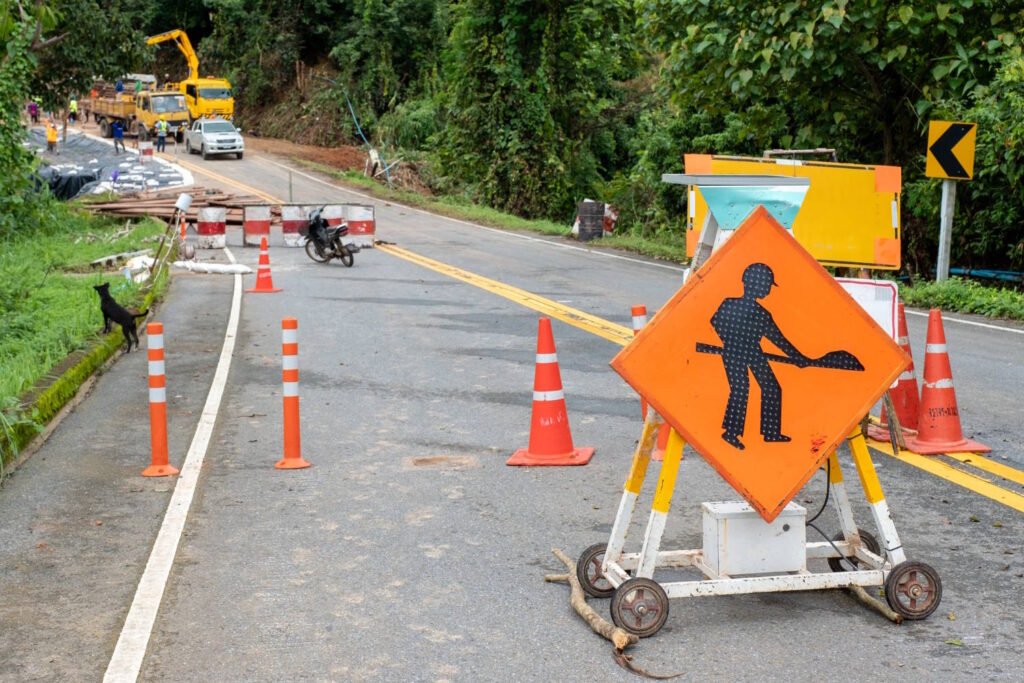Work zones and construction areas present unique challenges for drivers that require increased attention and caution. These areas are designed to allow for necessary road maintenance and improvements while maintaining traffic flow, but they come with specific risks and regulations that all drivers must understand.
Rules for Navigating Work Zones Safely
- Slow Down: Reduced speed limits in work zones are mandatory, not suggested. Fines for speeding in work zones are often doubled.
- Eliminate Distractions: Put down your phone, turn down the radio, and focus completely on the road ahead.
- Maintain Extra Following Distance: Keep at least a 3-second following distance between you and the vehicle ahead to allow for sudden stops.
- Watch for Workers: Be alert for workers who may be close to or entering the roadway.
- Obey All Signs and Instructions: Follow all posted signs, and especially obey instructions from flaggers.
- Expect the Unexpected: Be prepared for vehicles to slow, stop, or change lanes without warning.
- Merge Early: When approaching lane closures, merge as soon as safely possible rather than zooming ahead and merging at the last moment.
- Be Patient: Remember that the work zone exists to improve the road for future use.
- Turn On Headlights: This makes your vehicle more visible to workers and other drivers.
- Plan Ahead: Check your route before traveling and allow extra time if you’ll be passing through work zones.
What is a Work Zone?
A work zone is a designated area on or near a roadway where construction, maintenance, utility work, or other activities are taking place. These zones are carefully planned to allow work to proceed safely while minimizing disruption to traffic flow. Work zones typically feature:
- Altered traffic patterns
- Reduced speed limits
- Lane closures or shifts
- Temporary barriers or cones
- Special signage and signals
- Presence of workers and equipment
Why Work Zone Safety Matters
According to the Federal Highway Administration, there were 857 fatal crashes in work zones in 2020, resulting in 774 fatalities. Many of these accidents could have been prevented with proper driver attention and adherence to work zone regulations.
Common Work Zone Signs and Devices
Check out what is the main color for signs in highway work zones?
Warning Signs

- Orange Diamond-Shaped Signs: The most common work zone signs are orange with black lettering or symbols. These alert drivers to upcoming work zones and specific hazards.
- Advance Warning Signs: These appear before you reach the work zone, often with messages like “Road Work Ahead” or “Construction Zone Ahead.”
Traffic Control Devices

- Channelizing Devices: These include:
- Cones
- Barrels/drums
- Tubular markers
- Vertical panels
- Barricades
- Arrow Boards: Large electronic signs with flashing arrows indicating required lane changes or merges.
- Temporary Traffic Signals: Used when normal traffic flow is disrupted, such as when a two-way road is reduced to a single lane.
- Flaggers: Workers with stop/slow paddles who direct traffic through the work zone. Always follow their instructions, even if they contradict regular traffic signals.
The “Move Over” Law
All 50 states have enacted “Move Over” laws that require drivers to change lanes or slow down when approaching stationary emergency vehicles, maintenance vehicles, utility vehicles, or tow trucks with flashing lights. In many states, this law has been expanded to include construction vehicles as well.
What Happens If You Violate Work Zone Rules?
Consequences for violating work zone rules can include:
- Doubled or tripled fines for speeding and other violations
- Higher insurance rates
- License suspension for serious infractions
- Criminal charges if your actions result in injury or death
Speed limits through work zones
In the United States, work zone speed limits are determined by federal guidelines and state-specific regulations to ensure the safety of both workers and motorists.
The Federal Highway Administration (FHWA) recommends that speed limits in work zones be reduced only in areas where specific conditions or restrictive features are present, with a typical maximum reduction of 10 mph unless more significant hazards justify a greater decrease.
These reduced speed limits are part of the work zone’s traffic control plan and are influenced by factors such as the proximity of workers to traffic, the type of traffic control devices used, and the complexity of the work zone.
Enforcement measures, including the presence of law enforcement officers and automated speed enforcement systems, are employed to ensure compliance with these speed limits and enhance safety within work zones.
Remember:
The workers in construction zones are often just feet away from moving traffic. They rely on your careful driving to ensure they return home safely to their families each night. By maintaining focus and following work zone guidelines, you help protect not only yourself and your passengers but also the workers who are improving our roadways.
Frequently Asked Questions About Work Zone Safety
-
Why are work zones set up over long stretches when work seems limited to a small area?
Work zones may appear longer than the active work area because they include space for equipment, materials, and safety buffers. This setup ensures the safety of both workers and drivers by providing adequate space for unexpected situations. -
What are the penalties for speeding in a work zone?
Speeding in work zones often results in doubled or even tripled fines. In some jurisdictions, causing injury or death due to speeding can lead to criminal charges, including potential jail time. -
Why is it important to maintain extra following distance in work zones?
Rear-end collisions are the most common type of work zone crash. Maintaining a safe following distance allows drivers more time to react to sudden stops or changes in traffic patterns.


